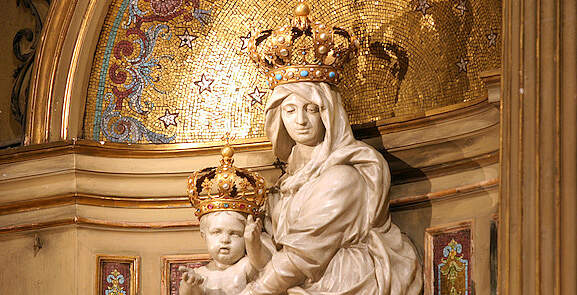
One of the 16 churches in Paris to be designated as a Minor Basilica, Our Lady of Victories (Notre-Dame-des-Victoires), is one of the most popular churches in Paris, although many visitors are not aware of it. It dates back to the 17th century, although the story gets more interesting in the 19th century, in 1836 to be exact.
Notre-Dame-des-Victoires is the former chapel of the Augustinian fathers (Petits-Pères), built between the years 1629-1740.https://en.wikipedia.org/wiki/Basilica_of_Notre-Dame-des-Victoires,_Paris#cite_note-1 The construction was funded by King Louis Louis XIII on the condition that it be dedicated to his victory over the Protestants at La Rochelle, which he attributed to the intercession of the Blessed Mother. The king wished to entrust all future military campaigns to Mary.
In October 1637, Brother Fiacre de Sainte-Marguerite (1609-1684) received a revelation telling him to have the people of France recite novenas for the birth of an heir to the throne of France, the future Louis XIV. During the French Revolution, the monks were dispersed and the closed church, stripped of its works of art, was transformed into headquarters of the National Lottery and stock exchange. The church was reopened for worship in 1809 and became a parish church.
There were few parishioners, as it was in a commercial area, and in fact the priest, Fr. Charles Dufriche-Desgenettes, was considering resigning due to what he perceived to be a failure of his ministry. On December 3rd of that year he received interior locutions from the Blessed Mother. She told him to consecrate the parish to the Immaculate Heart of Mary.
In a great act of faith, the priest entrusted the pastoral success of his parish to the Virgin Mary, and created a spiritual organization in honor of the Immaculate Heart of the Blessed Virgin Mary. The purpose of this organization, he wrote, was to obtain the conversion of all sinners from the Divine Mercy, through the protection and prayers of Mary. From this time on, the members have prayed and the faithful have multiplied.
The history does not stop there. Many seminarians and priests visited the parish, including Saint John Henry Newman, who went there to give thanks for his conversion. Other visitors among the thousands of faithful were Therese Martin (later to become Saint Therese of Lisieux), who prayed before the statue asking for Our Lady’s help in fulfilling her vocation, as well as Saint John Bosco. The most striking feature to many are the thousands (roughly 37,000) ex-votos on display giving thanks for prayers answered.
Adapted from: Our History with Mary and The Catholic Travel Guide